您好,登錄后才能下訂單哦!
您好,登錄后才能下訂單哦!
and操作:
????隱式and操作:
????????db.getCollection("the_table").find({"age":{"$gt":20},"sex":"男"})?? //對age與sex這兩個字段的查詢條件需要同時滿足
????顯式and操作:
????????db.getCollection("the_table").find({"$and":[{"age":{"$gte":20}},{"address":"里世界"}]})
????顯式、隱式混用:
????????db.getCollection("the_table").find({
?? ?????????"id":{"$lt": 10},
?? ?????????"$and": [{"age": {"$gt": 20}}, {"sex": "男"}]
????????})
????不能寫成隱式and操作的例子:
????????db.getCollection("the_table").find({
?? ?????????"$and": [
?? ??? ?????????{"$or": [{"age": {"$gt": 28}}, {"salary": {"$gt": 9900}}]},
?? ??? ?????????{"$or": [{"sex": "男"}, {"id": {"$lt": 20}}]}
?? ?????????]
????????})
or操作:
??? 年齡大于28,或工資大于9900的:
????????db.getCollection("the_table").find({
?? ?????????"$or": [{"age": {"$gt": 28}},{"salary":{"$gt": 9900}}]
????????})
????(注意:mongodb在執行or操作時會遵循一個"短路原則":只要前面的條件滿足了,那后面的條件直接跳過。如果age大于28 ,那就不需要去檢查salary的值是多少。只有在age不滿足查詢條件時,才會去檢查salary的值)
????OR操作一定是顯式的,不存在隱式的OR操作
????而這里去可以把or兩邊的都顯示出來:
?? ???? > db.getCollection("the_table").find()
?? ??? ?......
?? ??? ?{ "_id" : ObjectId("5d10400adc4728bc5f52f3ca"), "username" : "張三" }
?? ??? ?{ "_id" : ObjectId("5d104011dc4728bc5f52f3cb"), "username" : "李四" }
?? ??? ?> db.getCollection("the_table").find({"$or":[{"username":"張三"},{"username":"李四"}]})
?? ??? ?{ "_id" : ObjectId("5d10400adc4728bc5f52f3ca"), "username" : "張三" }
?? ??? ?{ "_id" : ObjectId("5d104011dc4728bc5f52f3cb"), "username" : "李四" }
?? ??? ?>
嵌入式文檔的查詢:
??? 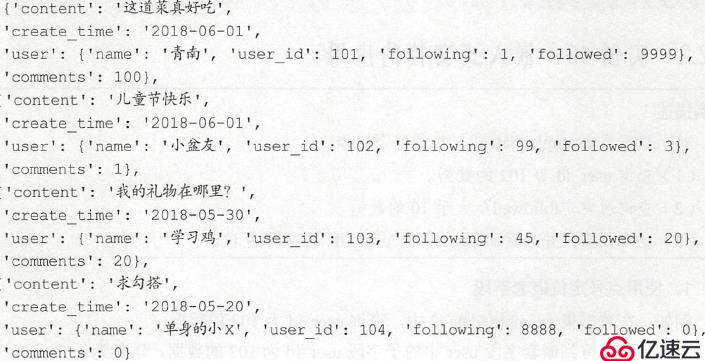
????嵌入字段只是定位的時候多了一步。除此之外,嵌入字段和普通字段沒有區別。
????查詢所有followed大于10的數據:
????????db.getCollection("the_table").find({"user.followed": {"$gt": 10}})
????如需要在返回的查詢結果中只顯示嵌入式文檔中的部分內容,也可以使用點號來實現。例如只返回"name"和"user_id"這兩個字段,查詢語句:
????????db.getCollection("the_table").find(
?? ?????????{"user.followed": {"$gt": 10}},
?? ?????????{"_id": 0, "user.name": 1, "user.user_id": 1}
????????)
???
包含與不包含:
????查出所有size包含M的數據:
????????db.getCollection("the_table").find({"size": "M"})
????????
????查出所有size不包含M的數據:
????????db.getCollection("the_table").find({"size": {"$ne": "M"}})
????????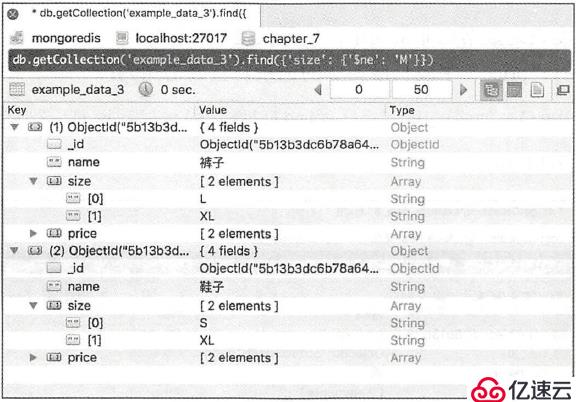
????數組中有元素在另一個范圍空間內:
????????db.getCollection("the_table").find({"price": {"$lt": 300, "$gt": 200}}
數組應用:
????根據數組長度查詢數據:
????????從數據集the_table中查詢所有price長度為2的記錄:
????????????db.getCollection("the_table").find({"price": {"$size": 2}})
????????????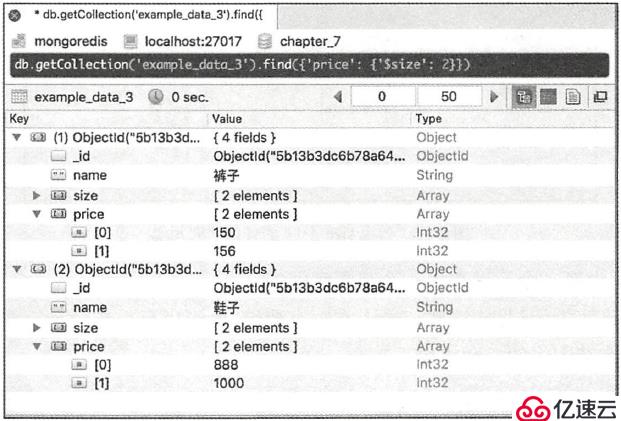
????根據索引查詢數據(索引是從0 開始的):
????????查詢所有“ size ”的第1個(索引為0)數據為“ S ”的記錄,查詢語句為:
????????????db.getCollection("the_table").find({"size.0": "S"})
????????????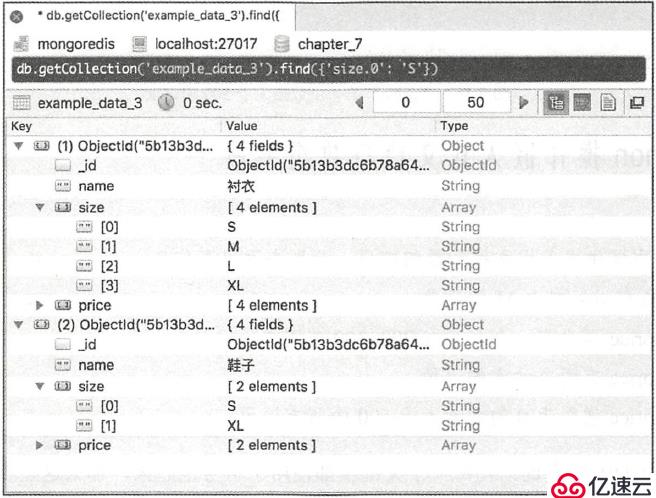
????????使用索引也可以比較大小。例如,查詢“price ”第1 個數據大于500 的所有記錄:
????????????db.getCollection("the_table").find({"price.0": {"$gt": 500}})
????????????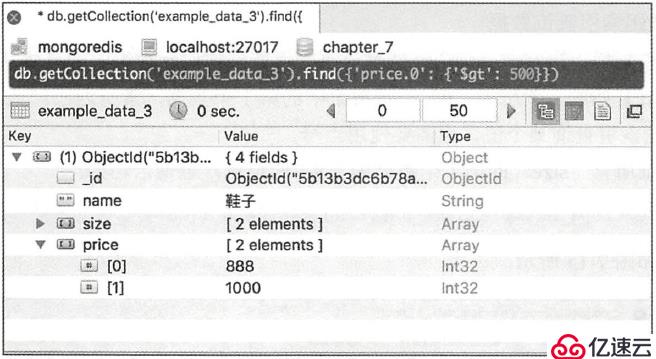
高級更新:
????最好用$push或$addToSet,這兩個命令都是往數組中添加數據,但$addToSet是唯一的,阻止了重復數據
????????db.getCollection("the_table").update(
?? ??? ??? ?{"favorites.movies": "Cassablanca"},
?? ??? ??? ?{"$addToSet": {"favorites.movies": "the maltese falcon"}},
?? ??? ??? ?false,
?? ??? ??? ?true
?? ??? ?)
??????? 第一個參數:匹配電影列表中包含Cassablanca的用戶
????????第二個參數:使用$addToSet添加the maltese falcon到列表中
????????第三個參數:false,控制是否允許upsert。這個命令告訴更新操作,當一個文檔不存在的時候是否插入它,這取決于更新操作是操作符更新還是替換更新
????????第四個參數:true,表示是否更新多個更新。默認情況下,mongodb更新只針對第一個匹配文檔。如果想更新所有匹配文檔,就必須顯示指定這個參數。
刪除數據:
????db.user.remove({"favorites.cities":"Cheyenne"})
????注意:remove()操作不會刪除集合,它只會刪除集合中的某個文檔。我們可以把它和sql中的delete命令類比。如果要刪除集合以及附帶的索引數據,可以用drop()方法:
????db.user.drop()
MongoDB的聚合查詢:
????使用聚合功能,可以直接讓MongoDB來處理數據。聚合功能可以把數據像放入傳送帶一樣,先把原始數據按照一定的規則進行篩選處理,然后通過多個不同的數據處理階段來處理數據,最終輸出一個匯總的結果。
????聚合操作的命令為"aggregate",基本格式為:collection.aggregate([階段1,階段2,階段3, ……,階段N])
????聚合操作可以有0 個、l 個或者多個階段。如果有0 個階段,則查詢命令寫為:collection.aggregate()。那么它的作用和collection.find() 一樣
????如果聚合有至少一個階段,那么每一個階段都是一個字典。不同的階段負責不同的事情,每一個階段有一個關鍵字。有專門負責篩選數據的階段“ $match ’3 ,有專門負責宇段相關的階段“ $pr句ect”,有專門負責數據分組的階段“$group"等。聚合操作有幾十個不同的階段關鍵字
????一般情況下,并非所有的數據都需要被處理,因此大多數時候聚合的第一個階段是數據篩選。就像find()一樣,把某些滿足條件的數據選出來以便后面做進一步處理。數據篩選的關鍵字為$match,它的用法為:collection.aggregate([{"$match":{和find 完全一樣的查詢表達式}}])
????????從the_table數據集中,查詢age大于等于27,且sex為“女”的所有記錄:
????????????db.getCollection("the_table").aggregate([
?? ?????????????{"$match": {"age": {"$gte": 27}, "sex": "女"}}
????????????])
????????從查詢結果來看,這一條聚合查詢語句的作用完全等同于:
????????????db.getCollection("the_table").find({"age": {"$gte": 27}, "sex": "女"})
????????這兩種寫法,核心查詢語句{"age": {"$gte": 27} , "sex":"女"}完全一樣。聚合查詢操作中的{"$match":{和find完全一樣的查詢表達式}}","$match"作為一個字典的Key,字典的Value和"find()"第1個參數完全相同。"find()"第1個參數能怎么寫,這里就能怎么寫。
????????例如,查詢所有age大于28或sex為男的記錄,聚合查詢可以寫為:
????????????db.getCollection("the_table").aggregate([
?????????????? ?{"$match": {"$or": [{"age": {"$gt": 28}}, {"sex": "男"}]}}
????????????])
????????從效果上看,使用聚合查詢與直接使用“自nd()” 效果完全相同,而使用聚合查詢還要多敲幾次鍵盤,那它的好處在哪里呢?聚合操作的好處在于“ 組合” 。接下來會講到更多的聚合關鍵字,把這些關鍵字組合起來才能體現出聚合操作的強大。
????篩選與修改字段:
????????$project來實現一個己經有的功能一一只返回部分字段(這里的字段過濾語句與find()第2個參數完全相同)
????????????db.getCollection("the_table").aggregate([
?? ?????????????{"$project": {"_id":0, "sex":1, "age":1}}
????????????])
??? 先篩選記錄,再過濾字段:
????????db.getCollection("the_table").aggregate([
?? ???? ????{"$match": {"age": {"$gt": 28}}}
?? ?????????{"$project": {"_id":0, "sex":1, "age":1}},
??????? ])
????添加新字段:
????????db.getCollection("the_table").aggregate([
?? ?????????{"$project": {"_id":0, "sex":1, "age":1, "newfield": "hello world"}},
?? ?????????{"$match": {"age": {"$gt": 28}}}
????????])
????????
????????(newfield是原來沒有的字段)
????
????復制現有字段:
????????db.getCollection("the_table").aggregate([
?? ?????????{"$match": {"age": {"$gt": 28}}},
?? ?????????{"$project": {"_id":0, "sex":1, "age":1, "newfield": "$age"}}
????????])
????????
????????
????修改現有字段的數據:
????????db.getCollection("the_table").aggregate([
?? ?????????{"$match": {"age": {"$gt": 28}}},
?????????? ?{"$project": {"_id":0, "sex":1, "age":1, "newfield": "this is new field"}}
????????])
????????
????注意:這并不會改變數據庫里的數據,只是改變輸出的數據
????????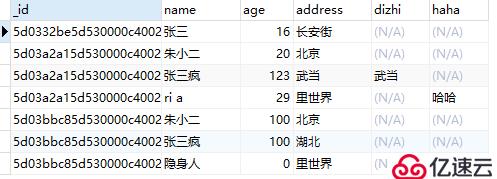
????????(數據并沒有變化)
????抽取嵌套字段:
????????上面的:添加新字段、復制現有字段、修改現有字段的數據等,看起來并沒有卵用,而下面的例子就有用了:
????????????如果用find(),想返回user_id和name,則查詢語句為:
????????????????db.getCollection("the_table").find({},{"user.name":1, "user.user_id":1})
????????????返回結果為:
????????????????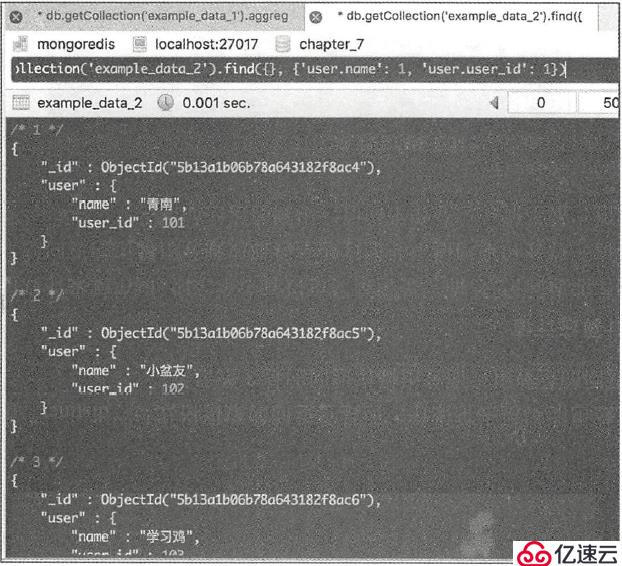
????????????????(顯然,嵌套字段處理起來并不方便)
????????????現在用$project將嵌套字段中的內容抽取:
????????????????db.getCollection("the_table").aggregate([
?? ?????????????????{"$project": {"name":"$user.name", "user_id":"$user.user_id"}}
????????????????])
????????????????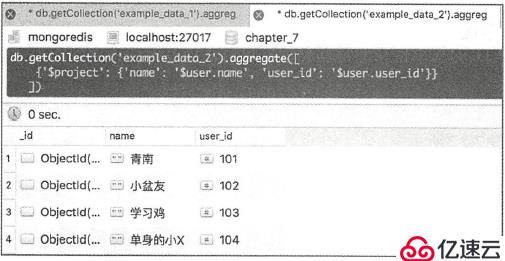
????處理字段特殊值:
????????? 如果想添加一個字段,但是這個字段的值就是數字“ 1 ”會怎么樣?
????????? 如果添加一個字段,這個字段的值就是一個普通的字符串,但不巧正好以“$”開頭,又會怎么樣呢?
??????? 關鍵字:$literal
????????db.getCollection("the_table").aggregate([
?? ?????????{"$match": {"age": {"$gt": 28}}},
?? ?????????{"$project": {"_id":0, "id":1, "hello": {"$literal":"$normalstring"}, "abcd":{"$literal":1}}}
????????])
????????
????分組操作:
??????? 去重的格式:db.getCollection("the_table").aggregate([{"$group": {"_id": "$被去重的字段名"}}])
????????????db.getCollection("the_table").aggregate([
?? ?????????????{"$group": {"_id": "$name"}}
????????????])
????????????
????????????分組操作雖然也能實現去重操作,但是它返回的數據格式與distinct函數是不一樣的。distinct函數返回的是數組,而分組操作返回的是幾條記錄
????????去重并統計:
????????????db.getCollection("the_table").aggregate([
?? ?????????????{"$group": {"_id": "$name","max_age":{"$max":"$age"},"min_age":{"$min":"$age"},"avg_age":{"$avg":"$age"},"sum_age":{"$sum":"$age"}}}
????????????])
??????????? 
????????原則上,$sum和$avg的值對應的字段的值應該都是數字。如果強行使用值為非數字的字段,那么$sum會返回0, $avg會返回null。而字符串是可以比較大小的,所以,$max與$min可以正常應用到字符串型的字段
????????還可以使用$sum的值為數字1來統計多少條記錄:
????????????db.getCollection("the_table").aggregate([
?? ?????????????{"$group": {"_id": "$name","doc_count":{"$sum":1},"max_age":{"$max":"$age"},"min_age":{"$min":"$age"},"avg_age":{"$avg":"$age"},"sum_age":{"$sum":"$age"}}}
????????????])
????????????
????分組/去重、最新一條數據:
????????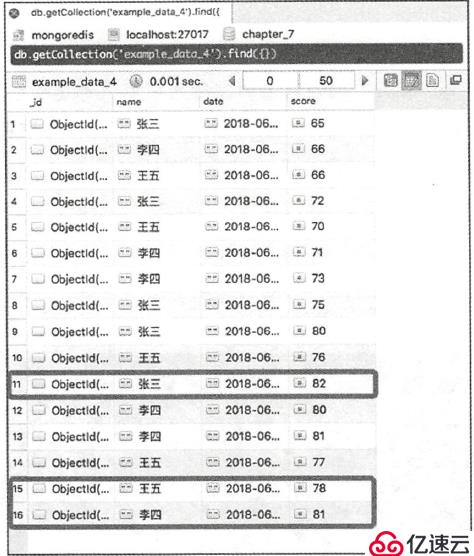
????????db.getCollection("the_table").aggregate([
?? ?????????{"$group": {"_id": "$name","age":{"$last":"$age"},"address":{"$last":"$address"}}}
????????])
????????
????
????可以取最新的數據,自然可以取最早的數據:
????????db.getCollection("the_table").aggregate([
?? ?????????{"$group": {"_id": "$name","age":{"$first":"$age"},"address":{"$first":"$address"}}}
????????])
????????
????
????拆分數組(用關鍵字:$unwind):
????????格式:collection.aggregate([{"$unwind":"$字段名"}])
????????db.getCollection("the_table").aggregate([
?? ?????????{"$unwind":"$size"}
????????])
????????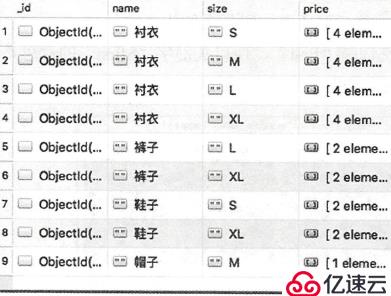
????????還可以把price數組也拆分:
????????db.getCollection("the_table").aggregate([
?? ?????????{"$unwind":"$size"},
?? ?????????{"$unwind":"$price"}
????????])
????????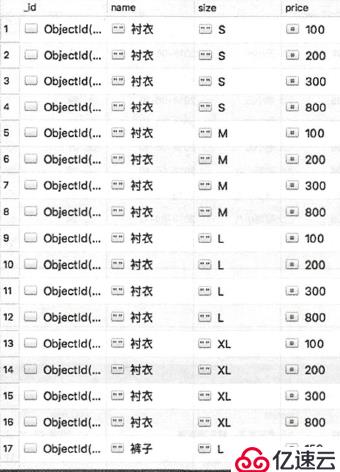
????聯集合查詢:
????????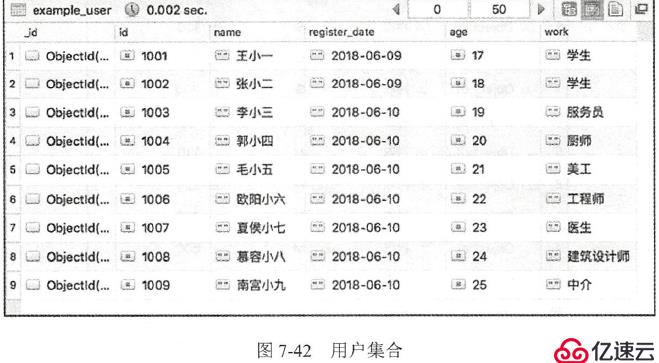
????????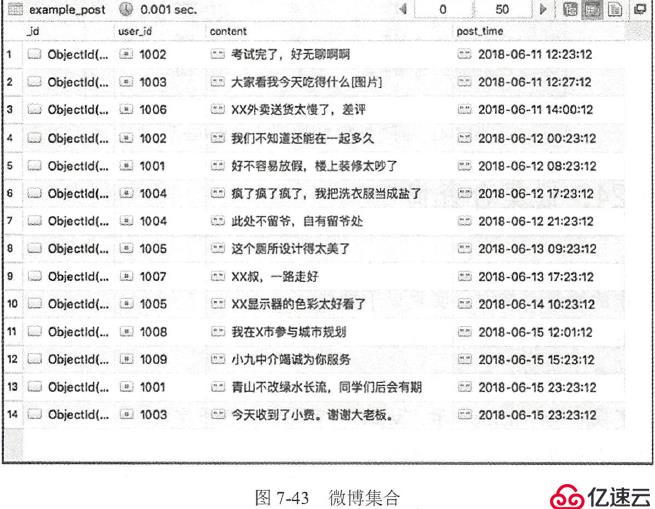
????????主集合.aggregate([
?? ?????????{
?? ??? ?????????"$lookup": {
?? ??? ??????????? ?"from": "被查集合名",
?? ??? ??????????? ?"localField": "主集合的字段",
?? ??????????? ??? ?"foreignField": "被查集合的字段",
?? ??????????? ??? ?"as": "保存查詢結果的字段名"
?? ??????????? ?}
?? ?????????}
????????])
????????其中的“主集合”與“被查集合”需要搞清楚。如果順序搞反了, 則結果會不同。
????????例如, 現在需要在做博集合中查詢用戶信息, 那么主集合就是微博集合, 被查集合就是用戶集合。于是查詢語句可以寫為以下:
????????????db.getCollection("example_post").aggregate([
?? ?????????????{"$lookup":{
?????????????? ??? ?"from": "example_user",
?????????????? ??? ?"localField": "user_id",
?????????????? ??? ?"foreignField": "id",
?????????????? ??? ?"as": "user_info"
?????????????? ?}}
????????????])
????????????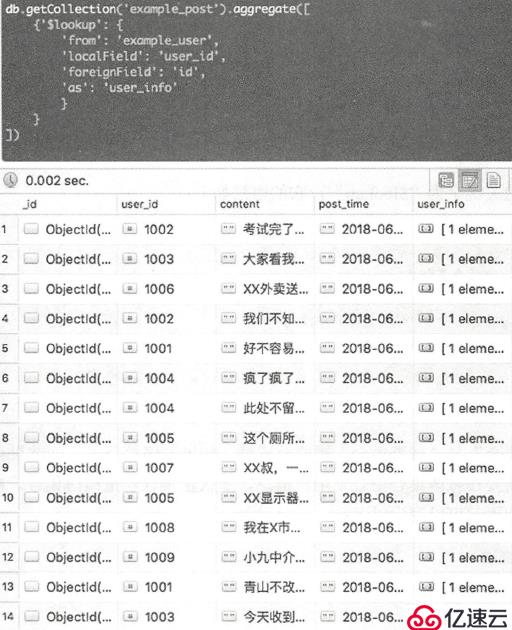
????????????(這里user_info字段之所以會是一個數組,是因為被查詢集合中可能有多條記錄都滿足條件,只有使用數組才能把它們都保存下來。由于用戶集合每一個記錄都是唯一的,所以這個數組只有一個元素)
????????????聯集合查詢并美化結果:
????????????????db.getCollection("example_post").aggregate([
?????????????????? ?{"$lookup":{
?????????????????? ??? ?"from": "example_user",
?????????????????? ??? ?"localField": "user_id",
?????????????????? ??? ?"foreignField": "id",
?????????????????? ??? ?"as": "user_info"
?????????????????? ?}},
?????????????????? ?{"$unwind":"$user_info"}
????????????????])
????????????????
????????????當然,還可以將聯集合查詢拆分結果返回特定內容:
????????????????db.getCollection("example_post").aggregate([
?? ???? ????????????{"$lookup":{
?? ????? ????????????? ?"from": "example_user",
?? ????? ????????????? ?"localField": "user_id",
?? ???? ?????????????? ?"foreignField": "id",
?? ???? ?????????????? ?"as": "user_info"
?? ???? ????????????}},
?? ??? ?????????????{"$unwind":"$user_info"},
?? ??? ?????????????{"$project":{
?? ??? ??????????????? ?"content": 1,
?? ??? ??????????????? ?"post_time": 1,
?? ??? ??????????????? ?"name": "$user_info.name",
?? ??? ??????????????? ?"work": "$user_info.work"
?? ??? ?????????????}}
??? ????????????])
????????????????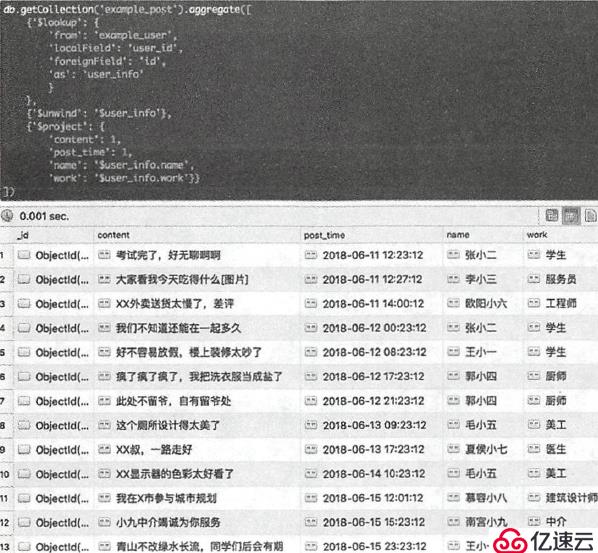
????????????以用戶為基準聯集合查詢:
????????????????db.getCollection("example_user").aggregate([
?????????????????? ?{"$lookup":{
?? ???? ?????????????? ?"from": "example_post",
?? ???? ?????????????? ?"localField": "id",
?? ???? ?????????????? ?"foreignField": "user_id",
?? ??? ??????????????? ?"as": "weibo_info"
?? ??? ?????????????}},
?? ??? ?????????????{"$unwind":"$weibo_info"},
?? ??? ?????????????{"$project":{
?? ??? ??????????????? ?"name": 1,
?? ??? ??????????????? ?"work": 1,
????? ???????????? ??? ?"content": "$weibo_info.name",
????? ???????????? ??? ?"post_time": "$weibo_info.work"
???? ????????????? ?}}
??? ????????????])
????????????????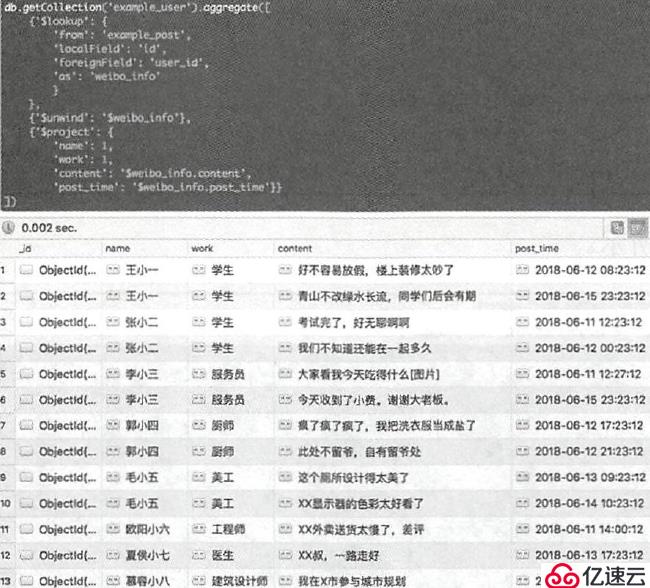
???????????
??????????? 還可以指定只查某人的:
????????????????db.getCollection("example_user").aggregate([
?? ?????????????????{"$match": {"name": "張三瘋"}},
?????????????????? ?{"$lookup":{
?? ??? ???? ????????????"from": "example_post",
?? ??? ??? ?????????????"localField": "id",
?? ??? ??? ?????????????"foreignField": "user_id",
?? ?????? ???????????? ?"as": "weibo_info"
?? ???? ????????????}},
?? ???? ????????????{"$unwind":"$weibo_info"},
?? ???? ????????????{"$project":{
?? ???? ?????????????? ?"content": 1,
?? ???? ?????????????? ?"post_time": 1,
?? ???? ?????????????? ?"name": "$weibo_info.name",
?? ????? ????????????? ?"work": "$weibo_info.work"
?? ??? ?????????????}}
??? ????????????])
????????????????(從性能上講,建議把$match放在最前面,這樣可以充分用到mongodb的索引)
免責聲明:本站發布的內容(圖片、視頻和文字)以原創、轉載和分享為主,文章觀點不代表本網站立場,如果涉及侵權請聯系站長郵箱:is@yisu.com進行舉報,并提供相關證據,一經查實,將立刻刪除涉嫌侵權內容。